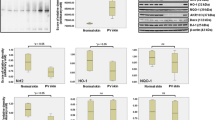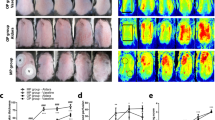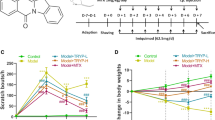Abstract
Psoriasis is a chronic inflammatory skin disease that is thought to be related to oxidative stress. Much progress has been made in understanding the pathophysiology of psoriasis in relation to the immunologic and antioxidant systems. However, this progress has been hindered by the lack of an appropriate animal model for psoriasis. Recently, imiquimod (IQM)-induced psoriasis-like cutaneous inflammation has been reported in mice and humans. We verified the usefulness of an IQM-induced mouse model in relation to the antioxidant system. BALB/C female mice at 8–10 weeks of age were treated with IQM cream in this study. We analyzed clinical and histopathological changes. Increased reactive oxygen species production was measured by glutathione assay. Levels of myeloperoxidase (MPO) and superoxide dismutase-1 (SOD1) were determined by western blotting and immunohistochemical analyses. The activity of SOD was measured by a SOD activity assay kit. Application of IQM-induced skin inflammation similar to psoriasis in clinical and histopathological aspects. Accumulation of immune cells was confirmed. Oxidative stress was increased, the antioxidant enzyme MPO levels were increased, and both SOD levels and activity were decreased. In conclusion, the IQM-induced mouse model showed an aberrant antioxidant system. Levels of MPO and oxidative stress were increased, and the level and activity of SOD were decreased. Since this model seemed to be an appropriate model for psoriasis, it can be used to further study the pathogenic role of redox imbalance in psoriasis.





Similar content being viewed by others
References
Ardavin C (2003) Origin, precursors and differentiation of mouse dendritic cells. Nat Rev Immunol 3(7):582–590
Berking C, Takemoto R, Binder RL, Hartman SM, Ruiter DJ, Gallagher PM, Lessin SR, Herlyn M (2002) Photocarcinogenesis in human adult skin grafts. Carcinogenesis 23(1):181–187
Bhagavathula N, Nerusu KC, Fisher GJ, Liu G, Thakur AB, Gemmell L, Kumar S, Xu ZH, Hinton P, Tsurushita N, Landolfi NF, Voorhees JJ, Varani J (2005) Amphiregulin and epidermal hyperplasia: amphiregulin is required to maintain the psoriatic phenotype of human skin grafts on severe combined immunodeficient mice. Am J Pathol 166(4):1009–1016
Conrad C, Nestle FO (2006) Animal models of psoriasis and psoriatic arthritis: an update. Curr Rheumatol Rep 8(5):342–347
Danilenko DM (2008) Review paper: preclinical models of psoriasis. Vet Pathol 45(4):563–575
De Y, Chen Q, Schmidt AP, Anderson GM, Wang JM, Wooters J, Oppenheim JJ, Chertov O (2000) LL-37, the neutrophil granule- and epithelial cell-derived cathelicidin, utilizes formyl peptide receptor-like 1 (FPRL1) as a receptor to chemoattract human peripheral blood neutrophils, monocytes, and T cells. J Exp Med 192(7):1069–1074
Dogan P, Soyuer U, Tanrikulu G (1989) Superoxide dismutase and myeloperoxidase activity in polymorphonuclear leukocytes, and serum ceruloplasmin and copper levels, in psoriasis. Br J Dermatol 120(2):239–244
Dorschner RA, Pestonjamasp VK, Tamakuwala S, Ohtake T, Rudisill J, Nizet V, Agerberth B, Gudmundsson GH, Gallo RL (2001) Cutaneous injury induces the release of cathelicidin anti-microbial peptides active against group A Streptococcus. J Invest Dermatol 117(1):91–97
Gabr SA, Al-Ghadir AH (2012) Role of cellular oxidative stress and cytochrome c in the pathogenesis of psoriasis. Arch Dermatol Res 304(6):451–457
Ganguly D, Chamilos G, Lande R, Gregorio J, Meller S, Facchinetti V, Homey B, Barrat FJ, Zal T, Gilliet M (2009) Self-RNA-antimicrobial peptide complexes activate human dendritic cells through TLR7 and TLR8. J Exp Med 206(9):1983–1994
Gerbaud P, Petzold L, Therond P, Anderson WB, Evain-Brion D, Raynaud F (2005) Differential regulation of Cu, Zn- and Mn-superoxide dismutases by retinoic acid in normal and psoriatic human fibroblasts. J Autoimmun 24(1):69–78
Gilliet M, Conrad C, Geiges M, Cozzio A, Thurlimann W, Burg G, Nestle FO, Dummer R (2004) Psoriasis triggered by toll-like receptor 7 agonist imiquimod in the presence of dermal plasmacytoid dendritic cell precursors. Arch Dermatol 140(12):1490–1495
Godfrey DI, Hammond KJ, Poulton LD, Smyth MJ, Baxter AG (2000) NKT cells: facts, functions and fallacies. Immunol Today 21(11):573–583
Gudjonsson JE, Johnston A, Dyson M, Valdimarsson H, Elder JT (2007) Mouse models of psoriasis. J Invest Dermatol 127(6):1292–1308
Kharaeva Z, Gostova E, De Luca C, Raskovic D, Korkina L (2009) Clinical and biochemical effects of coenzyme Q (10), vitamin E, and selenium supplementation to psoriasis patients. Nutrition 25(3):295–302
Lande R, Gregorio J, Facchinetti V, Chatterjee B, Wang YH, Homey B, Cao W, Wang YH, Su B, Nestle FO, Zal T, Mellman I, Schroder JM, Liu YJ, Gilliet M (2007) Plasmacytoid dendritic cells sense self-DNA coupled with antimicrobial peptide. Nature 449(7162):564–569
Lowes MA, Bowcock AM, Krueger JG (2007) Pathogenesis and therapy of psoriasis. Nature 445(7130):866–873
Miyachi Y, Niwa Y (1983) Effects of psoriatic sera on the generation of oxygen intermediates by normal polymorphonuclear leucocytes. Arch Dermatol Res 275(1):23–26
Nagaoka I, Tamura H, Hirata M (2006) An antimicrobial cathelicidin peptide, human CAP18/LL-37, suppresses neutrophil apoptosis via the activation of formyl-peptide receptor-like 1 and P2X7. J Immunol 176(5):3044–3052
Nelson KC, Carlson JL, Newman ML, Sternberg P Jr, Jones DP, Kavanagh TJ, Diaz D, Cai J, Wu M (1999) Effect of dietary inducer dimethylfumarate on glutathione in cultured human retinal pigment epithelial cells. Invest Ophthalmol Vis Sci 40(9):1927–1935
Nestle FO, Conrad C, Tun-Kyi A, Homey B, Gombert M, Boyman O, Burg G, Liu YJ, Gilliet M (2005) Plasmacytoid predendritic cells initiate psoriasis through interferon-alpha production. J Exp Med 202(1):135–143
Nickoloff BJ, Wrone-Smith T (1999) Injection of pre-psoriatic skin with CD4+ T cells induces psoriasis. Am J Pathol 155(1):145–158
Nickoloff BJ, Xin H, Nestle FO, Qin JZ (2007) The cytokine and chemokine network in psoriasis. Clin Dermatol 25(6):568–573
Nikolic-Kokic A, Stevic Z, Blagojevic D, Davidovic B, Jones DR, Spasic MB (2006) Alterations in anti-oxidative defence enzymes in erythrocytes from sporadic amyotrophic lateral sclerosis (SALS) and familial ALS patients. Clin Chem Lab Med 44(5):589–593
Palamara F, Meindl S, Holcmann M, Luhrs P, Stingl G, Sibilia M (2004) Identification and characterization of pDC-like cells in normal mouse skin and melanomas treated with imiquimod. J Immunol 173(5):3051–3061
Patel U, Mark NM, Machler BC, Levine VJ (2011) Imiquimod 5 % cream induced psoriasis: a case report, summary of the literature and mechanism. Br J Dermatol 164(3):670–672
Popov I, Lewin G (1991) A deficient function of the antioxidative system of the organism as an aetiopathogenetic factor in psoriasis. Med Hypotheses 35(3):229–236
Portugal M, Barak V, Ginsburg I, Kohen R (2007) Interplay among oxidants, antioxidants, and cytokines in skin disorders: present status and future considerations. Biomed Pharmacother 61(7):412–422
Rajan N, Langtry JA (2006) Generalized exacerbation of psoriasis associated with imiquimod cream treatment of superficial basal cell carcinomas. Clin Exp Dermatol 31(1):140–141
Raynaud F, Evain-Brion D, Gerbaud P, Marciano D, Gorin I, Liapi C, Anderson WB (1997) Oxidative modulation of cyclic AMP-dependent protein kinase in human fibroblasts: possible role in psoriasis. Free Radic Biol Med 22(4):623–632
Schon MP, Schon M, Klotz KN (2006) The small antitumoral immune response modifier imiquimod interacts with adenosine receptor signaling in a TLR7- and TLR8-independent fashion. J Invest Dermatol 126(6):1338–1347
Shen T, Zhu QX, Yang S, Wu CH, Zhang HF, Zhou CF, Zhang XJ (2008) Trichloroethylene induced cutaneous irritation in BALB/c hairless mice: histopathological changes and oxidative damage. Toxicology 248(2–3):113–120
Swindell WR, Johnston A, Carbajal S, Han G, Wohn C, Lu J, Xing X, Nair RP, Voorhees JJ, Elder JT, Wang XJ, Sano S, Prens EP, DiGiovanni J, Pittelkow MR, Ward NL, Gudjonsson JE (2011) Genome-wide expression profiling of five mouse models identifies similarities and differences with human psoriasis. PloS one 6(4):e18266
Therond P, Gerbaud P, Dimon S, Anderson WB, Evain-Broin D, Raynaud F (1996) Antioxidant enzymes in psoriatic fibroblasts and erythrocytes. J Invest Dermatol 106(6):1325–1328
Thiele JJ, Schroeter C, Hsieh SN, Podda M, Packer L (2001) The antioxidant network of the stratum corneum. Curr Probl Dermatol 29:26–42
Utas S, Kose K, Yazici C, Akdas A, Kelestimur F (2002) Antioxidant potential of propylthiouracil in patients with psoriasis. Clin Biochem 35(3):241–246
van der Fits L, Mourits S, Voerman JS, Kant M, Boon L, Laman JD, Cornelissen F, Mus AM, Florencia E, Prens EP, Lubberts E (2009) Imiquimod-induced psoriasis-like skin inflammation in mice is mediated via the IL-23/IL-17 axis. J Immunol 182(9):5836–5845
Vanizor Kural B, Orem A, Cimsit G, Yandi YE, Calapoglu M (2003) Evaluation of the atherogenic tendency of lipids and lipoprotein content and their relationships with oxidant-antioxidant system in patients with psoriasis. Clin Chim Acta 328(1–2):71–82
Wierinckx A, Breve J, Mercier D, Schultzberg M, Drukarch B, Van Dam AM (2005) Detoxication enzyme inducers modify cytokine production in rat mixed glial cells. J Neuroimmunol 166(1–2):132–143
Young CN, Koepke JI, Terlecky LJ, Borkin MS, Boyd Savoy L, Terlecky SR (2008) Reactive oxygen species in tumor necrosis factor-alpha-activated primary human keratinocytes: implications for psoriasis and inflammatory skin disease. J Invest Dermatol 128(11):2606–2614
Zheng Y, Niyonsaba F, Ushio H, Nagaoka I, Ikeda S, Okumura K, Ogawa H (2007) Cathelicidin LL-37 induces the generation of reactive oxygen species and release of human alpha-defensins from neutrophils. Br J Dermatol 157(6):1124–1131
Zhou Q, Mrowietz U, Rostami-Yazdi M (2009) Oxidative stress in the pathogenesis of psoriasis. Free Radic Biol Med 47(7):891–905
Acknowledgments
This work was supported by a grant (A101323: J.-O. Baek) from the 2010 Good Health R&D Project, Ministry of Health and Welfare, Republic of Korea. The authors thank Dr. Do-Young Kim and Hyun-Joong Jee for helpful discussion.
Conflict of interest
The authors have no conflict of interest to declare.
Author information
Authors and Affiliations
Corresponding author
Additional information
J.-O. Baek and D. Byamba contributed equally to this article.
Rights and permissions
About this article
Cite this article
Baek, JO., Byamba, D., Wu, W.H. et al. Assessment of an imiquimod-induced psoriatic mouse model in relation to oxidative stress. Arch Dermatol Res 304, 699–706 (2012). https://doi.org/10.1007/s00403-012-1272-y
Received:
Revised:
Accepted:
Published:
Issue Date:
DOI: https://doi.org/10.1007/s00403-012-1272-y




